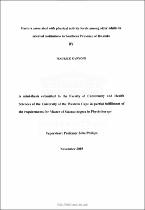| dc.contributor.advisor | Phillips, Julie | |
| dc.contributor.author | Kanyoni, Maurice | |
| dc.date.accessioned | 2023-06-19T09:08:33Z | |
| dc.date.available | 2023-06-19T09:08:33Z | |
| dc.date.issued | 2008 | |
| dc.identifier.uri | http://hdl.handle.net/11394/10285 | |
| dc.description | Magister Scientiae (Physiotherapy) - MSc(Physio) | en_US |
| dc.description.abstract | The size of the elderly population both in numbers and proportions of the whole world is increasing rapidly. The increase in the number of elderly people in the world will exert a big impact on health and social services. Population aging is also likely to cause serious
societal challenges due to its associated increase in the number of individuals at risk for chronic diseases and injury. Participation in regular physical activity elicits a number of favorable responses that contribute to healthy aging, it is therefore established that
physical activity is one way of limiting age related disabilities. Several studies have investigated factors that may be associated with physical activity participation and levels of physical activity in Rwanda among different age groups. However little has been done
to investigate physical activity levels among older adults in Rwanda. This study aims to asses the levels of physical activity and the factors associated with it among older adults in Rwanda. A cross-sectional and descriptive study with a quantitative design was conducted. Sixty-three (63) participants from two institutions for the elderly located in the Southern Province of Rwanda were purposively selected. An interview questionnaire with closed-ended questions was used to collect data. Descriptive and inferential data were analysed statistically with SPSS version 15.0. Frequencies and percentages were calculated for demographic data. Mean score values and standard deviations for each variable were calculated. Chi-square test was used to test the relationship between selected variables and physical activity participation. The mean age of the participants was 7l years (SD = 9.82; range : 55-l0l years) and more than half (58,7%) of the participants were females. Furthermore the majority of participants were widowed (58'7 %) andreported alcohol consumption (60.3 %). Females were significantly more likely to be physically active than males. Younger participants were more likely to be physically active than the older participants, although not statistically significant. No statistically significant association was found for physical activity participation, marital status, location of residence and education level. Fear of falling and alcohol consumption were significantly related to physical activity participation. Conclusively the study recommends that there is need to promote physical activity among older adults so that this part of the population do not loose on the benefits of physical activity. | en_US |
| dc.language.iso | en | en_US |
| dc.publisher | University of the Western Cape | en_US |
| dc.subject | Physical activity | en_US |
| dc.subject | Older adults | en_US |
| dc.subject | Chronic diseases of lifestyle | en_US |
| dc.subject | Physical exercise | en_US |
| dc.subject | Selected institutions | en_US |
| dc.title | Factors associated with physical activity levels among older adults in selected institutions in Southern Province of Rwanda | en_US |
| dc.rights.holder | University of the Western Cape | en_US |

